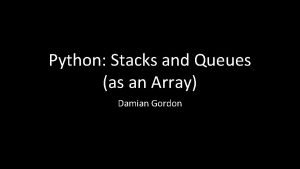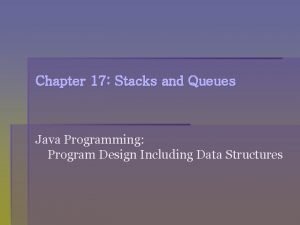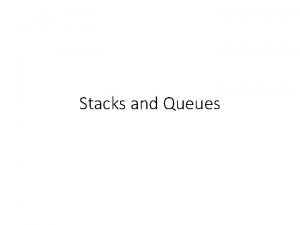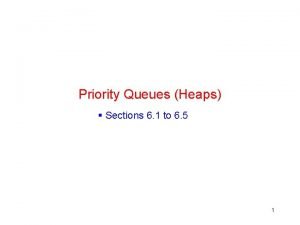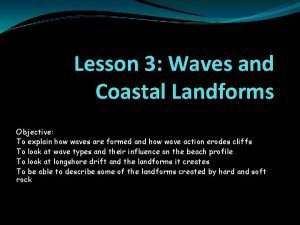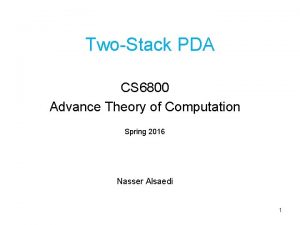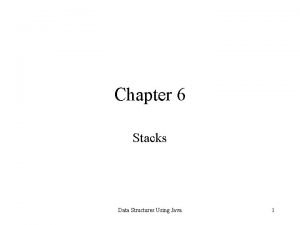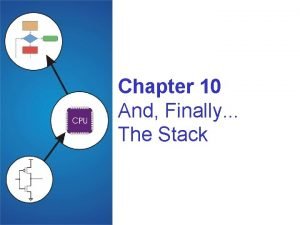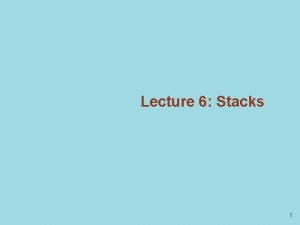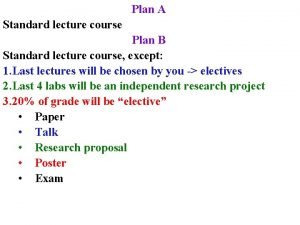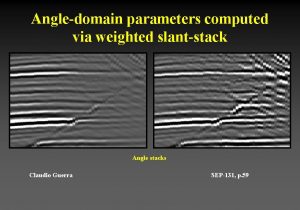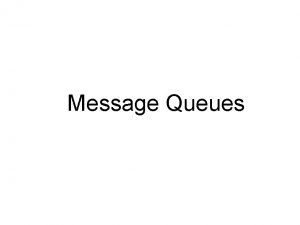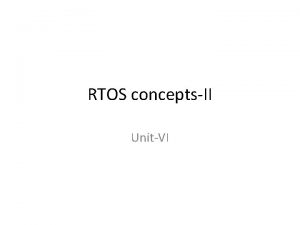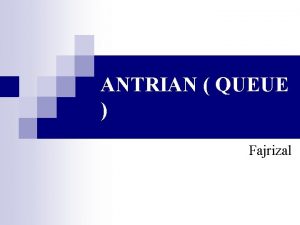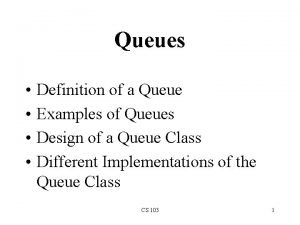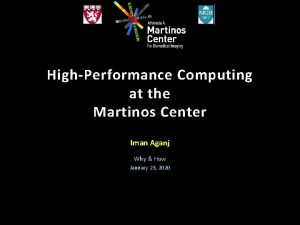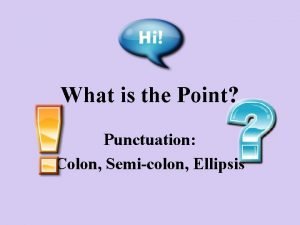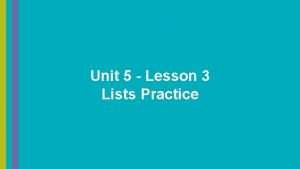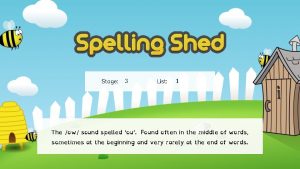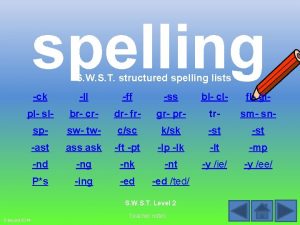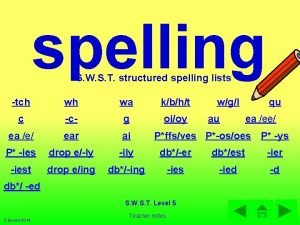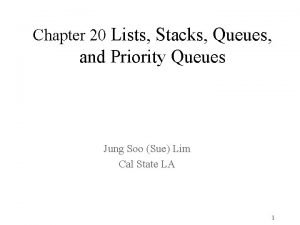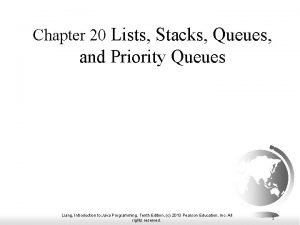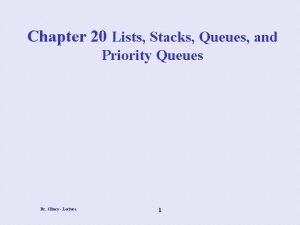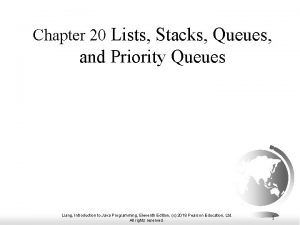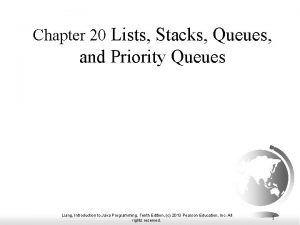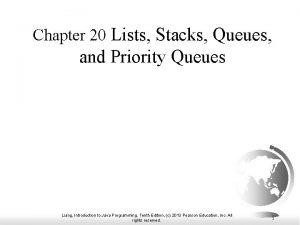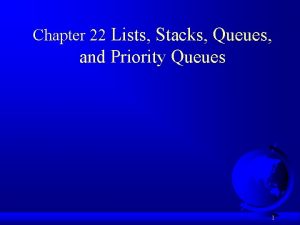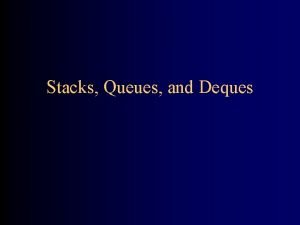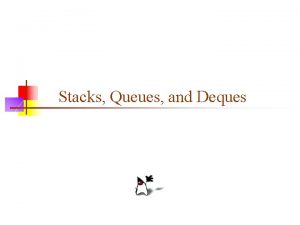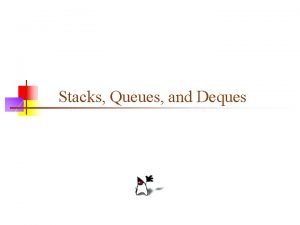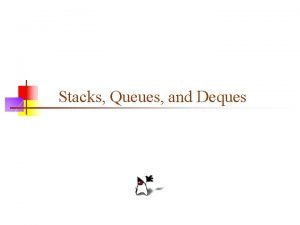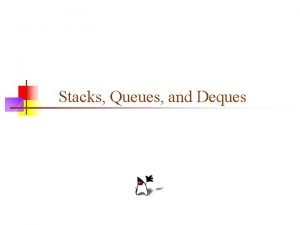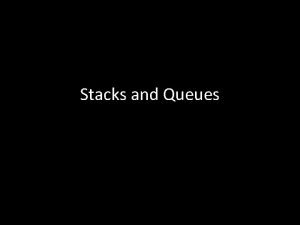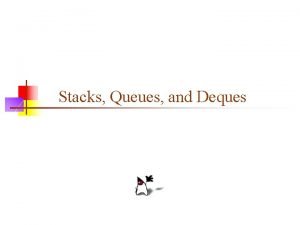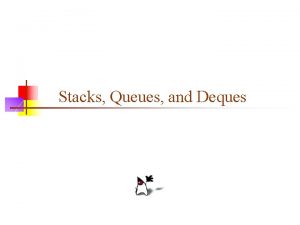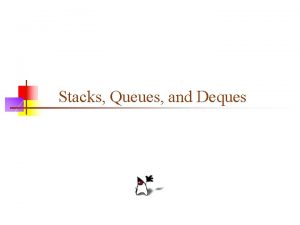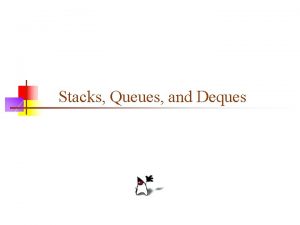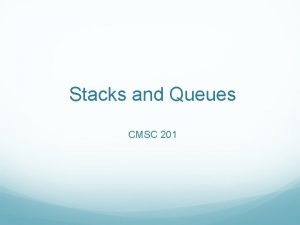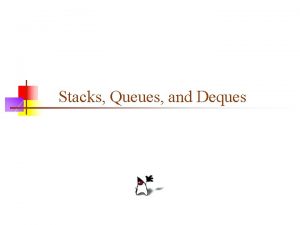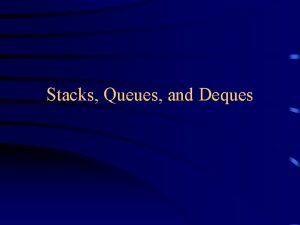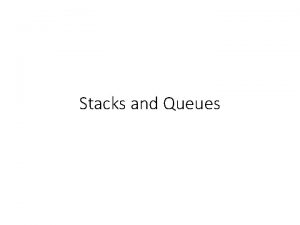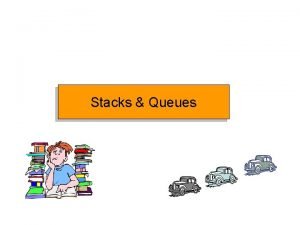Chapter 20 Lists Stacks Queues and Priority Queues






























- Slides: 30

Chapter 20 Lists, Stacks, Queues, and Priority Queues Liang, Introduction to Java Programming, Eleventh Edition, (c) 2018 Pearson Education, Ltd. All rights reserved. 1

Objectives q q q To explore the relationship between interfaces and classes in the Java Collections Framework hierarchy (§ 20. 2). To use the common methods defined in the Collection interface for operating collections (§ 20. 2). To use the Iterator interface to traverse the elements in a collection (§ 20. 3). To use a for-each loop to traverse the elements in a collection (§ 20. 3). To explore how and when to use Array. List or Linked. List to store elements (§ 20. 4). To compare elements using the Comparable interface and the Comparator interface (§ 20. 5). To use the static utility methods in the Collections class for sorting, searching, shuffling lists, and finding the largest and smallest element in collections (§ 20. 6). To develop a multiple bouncing balls application using Array. List (§ 20. 7). To distinguish between Vector and Array. List and to use the Stack class for creating stacks (§ 20. 8). To explore the relationships among Collection, Queue, Linked. List, and Priority. Queue and to create priority queues using the Priority. Queue class (§ 20. 9). To use stacks to write a program to evaluate expressions (§ 20. 10). Liang, Introduction to Java Programming, Eleventh Edition, (c) 2018 Pearson Education, Ltd. All rights reserved. 2

What is Data Structure? A data structure is a collection of data organized in some fashion. The structure not only stores data, but also supports operations for accessing and manipulating the data. Liang, Introduction to Java Programming, Eleventh Edition, (c) 2018 Pearson Education, Ltd. All rights reserved. 3

Java Collection Framework hierarchy A collection is a container object that holds a group of objects, often referred to as elements. The Java Collections Framework supports three types of collections, named lists, sets, and maps. Liang, Introduction to Java Programming, Eleventh Edition, (c) 2018 Pearson Education, Ltd. All rights reserved. 4

Java Collection Framework hierarchy, cont. Set and List are subinterfaces of Collection. Liang, Introduction to Java Programming, Eleventh Edition, (c) 2018 Pearson Education, Ltd. All rights reserved. 5

The Collection Interface The Collection interface is for manipulating a collection of objects. Liang, Introduction to Java Programming, Eleventh Edition, (c) 2018 Pearson Education, Ltd. All rights reserved. 6

The List Interface A list stores elements in a sequential order, and allows the user to specify where the element is stored. The user can access the elements by index. Liang, Introduction to Java Programming, Eleventh Edition, (c) 2018 Pearson Education, Ltd. All rights reserved. 7

The List Interface, cont. Liang, Introduction to Java Programming, Eleventh Edition, (c) 2018 Pearson Education, Ltd. All rights reserved. 8

The List Iterator Liang, Introduction to Java Programming, Eleventh Edition, (c) 2018 Pearson Education, Ltd. All rights reserved. 9

Array. List and Linked. List The Array. List class and the Linked. List class are concrete implementations of the List interface. Which of the two classes you use depends on your specific needs. If you need to support random access through an index without inserting or removing elements from any place other than the end, Array. List offers the most efficient collection. If, however, your application requires the insertion or deletion of elements from any place in the list, you should choose Linked. List. A list can grow or shrink dynamically. An array is fixed once it is created. If your application does not require insertion or deletion of elements, the most efficient data structure is the array. Liang, Introduction to Java Programming, Eleventh Edition, (c) 2018 Pearson Education, Ltd. All rights reserved. 10

java. util. Array. List Liang, Introduction to Java Programming, Eleventh Edition, (c) 2018 Pearson Education, Ltd. All rights reserved. 11

java. util. Linked. List Liang, Introduction to Java Programming, Eleventh Edition, (c) 2018 Pearson Education, Ltd. All rights reserved. 12

Example: Using Array. List and Linked. List This example creates an array list filled with numbers, and inserts new elements into the specified location in the list. The example also creates a linked list from the array list, inserts and removes the elements from the list. Finally, the example traverses the list forward and backward. Test. Array. And. Linked. List Run Liang, Introduction to Java Programming, Eleventh Edition, (c) 2018 Pearson Education, Ltd. All rights reserved. 13

The Comparator Interface Sometimes you want to compare the elements of different types. The elements may not be instances of Comparable or are not comparable. You can define a comparator to compare these elements. To do so, define a class that implements the java. util. Comparator interface. The Comparator interface has the compare method for comparing two objects. Liang, Introduction to Java Programming, Eleventh Edition, (c) 2018 Pearson Education, Ltd. All rights reserved. 14

The Comparator Interface public int compare(Object element 1, Object element 2) Returns a negative value if element 1 is less than element 2, a positive value if element 1 is greater than element 2, and zero if they are equal. Geometric. Object. Comparator Test. Comparator Run Liang, Introduction to Java Programming, Eleventh Edition, (c) 2018 Pearson Education, Ltd. All rights reserved. 15

Other Comparator Examples Sort. String. By. Length Run Sort. String. Ignore. Case Run Liang, Introduction to Java Programming, Eleventh Edition, (c) 2018 Pearson Education, Ltd. All rights reserved. 16

The Collections Class The Collections class contains various static methods for operating on collections and maps, for creating synchronized collection classes, and for creating readonly collection classes. Liang, Introduction to Java Programming, Eleventh Edition, (c) 2018 Pearson Education, Ltd. All rights reserved. 17

The Collections Class UML Diagram Liang, Introduction to Java Programming, Eleventh Edition, (c) 2018 Pearson Education, Ltd. All rights reserved. 18

Case Study: Multiple Bouncing Balls Multiple. Bounce. Ball Liang, Introduction to Java Programming, Eleventh Edition, (c) 2018 Pearson Education, Ltd. All rights reserved. Run 19

The Vector and Stack Classes The Java Collections Framework was introduced with Java 2. Several data structures were supported prior to Java 2. Among them are the Vector class and the Stack class. These classes were redesigned to fit into the Java Collections Framework, but their old-style methods are retained for compatibility. This section introduces the Vector class and the Stack class. Liang, Introduction to Java Programming, Eleventh Edition, (c) 2018 Pearson Education, Ltd. All rights reserved. 20

The Vector Class In Java 2, Vector is the same as Array. List, except that Vector contains the synchronized methods for accessing and modifying the vector. None of the new collection data structures introduced so far are synchronized. If synchronization is required, you can use the synchronized versions of the collection classes. These classes are introduced later in the section, “The Collections Class. ” Liang, Introduction to Java Programming, Eleventh Edition, (c) 2018 Pearson Education, Ltd. All rights reserved. 21

The Vector Class, cont. Liang, Introduction to Java Programming, Eleventh Edition, (c) 2018 Pearson Education, Ltd. All rights reserved. 22

The Stack Class The Stack class represents a last-in-firstout stack of objects. The elements are accessed only from the top of the stack. You can retrieve, insert, or remove an element from the top of the stack. Liang, Introduction to Java Programming, Eleventh Edition, (c) 2018 Pearson Education, Ltd. All rights reserved. 23

Queues and Priority Queues A queue is a first-in/first-out data structure. Elements are appended to the end of the queue and are removed from the beginning of the queue. In a priority queue, elements are assigned priorities. When accessing elements, the element with the highest priority is removed first. Liang, Introduction to Java Programming, Eleventh Edition, (c) 2018 Pearson Education, Ltd. All rights reserved. 24

The Queue Interface Liang, Introduction to Java Programming, Eleventh Edition, (c) 2018 Pearson Education, Ltd. All rights reserved. 25

Using Linked. List for Queue Liang, Introduction to Java Programming, Eleventh Edition, (c) 2018 Pearson Education, Ltd. All rights reserved. 26

The Priority. Queue Class Priority. Queue. Demo Liang, Introduction to Java Programming, Eleventh Edition, (c) 2018 Pearson Education, Ltd. All rights reserved. Run 27

Case Study: Evaluating Expressions Stacks can be used to evaluate expressions. Evaluate Expression Run Liang, Introduction to Java Programming, Eleventh Edition, (c) 2018 Pearson Education, Ltd. All rights reserved. 28

Algorithm Phase 1: Scanning the expression The program scans the expression from left to right to extract operands, operators, and the parentheses. 1. 1. If the extracted item is an operand, push it to operand. Stack. 1. 2. If the extracted item is a + or - operator, process all the operators at the top of operator. Stack and push the extracted operator to operator. Stack. 1. 3. If the extracted item is a * or / operator, process the * or / operators at the top of operator. Stack and push the extracted operator to operator. Stack. 1. 4. If the extracted item is a ( symbol, push it to operator. Stack. 1. 5. If the extracted item is a ) symbol, repeatedly process the operators from the top of operator. Stack until seeing the ( symbol on the stack. Phase 2: Clearing the stack Repeatedly process the operators from the top of operator. Stack until operator. Stack is empty. Liang, Introduction to Java Programming, Eleventh Edition, (c) 2018 Pearson Education, Ltd. All rights reserved. 29

Example Liang, Introduction to Java Programming, Eleventh Edition, (c) 2018 Pearson Education, Ltd. All rights reserved. 30
 Stacks and queues in python
Stacks and queues in python Java stacks and queues
Java stacks and queues Java stack exercises
Java stack exercises Java stacks and queues
Java stacks and queues 3 min quiz
3 min quiz Priority queue adt
Priority queue adt Applications of priority queues
Applications of priority queues Burman's priority list gives priority to
Burman's priority list gives priority to Priority mail vs priority mail express
Priority mail vs priority mail express Wave cut platform diagram
Wave cut platform diagram Pda
Pda Cliff terrace caves stacks
Cliff terrace caves stacks Types of stacks
Types of stacks Data structures using java
Data structures using java Stacks+routined
Stacks+routined 6 stacks
6 stacks Speed stacks spreads nationally in 1998.
Speed stacks spreads nationally in 1998. ро
ро Stacks internet
Stacks internet Angle stacks
Angle stacks Representation of queues
Representation of queues Message queues in unix
Message queues in unix Rtos mailbox
Rtos mailbox Types of queues in data structure
Types of queues in data structure Examples of queue
Examples of queue Aganj
Aganj Semicolon for lists
Semicolon for lists Lesson 3: lists practice
Lesson 3: lists practice Spelling shed
Spelling shed Swst spelling test
Swst spelling test Soft g word
Soft g word
